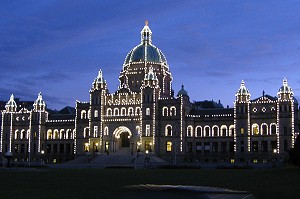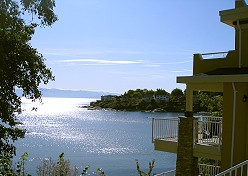
Queen Victoria of England dubbed the westernmost region of Canada British Columbia in 1858 — in tribute, her name remains on B. C. ‘s capital city and our destination, Victoria.
The chilled salt sea air was in our faces as we steamed north aboard the good ship Coho, crossing The Strait of Juan de Fuco toward the southern tip of Vancouver Island.

Just before our arrival we were treated to a breathtaking show. The captain announced that orcas were sighted off the starboard bow as he slowed the vessel to a crawl.
We bounded to the forward deck, grinning maniacally. Sure enough, two black and white killer whales were passing within a few hundred feet of the ship. The glorious glimpses of fluke and fin were a wonderful welcome.

Slipping into the harbor is a picturesque passage in and of itself. The port is dominated by two grand old buildings, The Parliament
Building and The Empress Hotel.
It’s not only the structures of these venerable landmarks that are so impressive but the grounds as
well. Meticulously manicured and managed — botanical gardens just a few steps from the ferry dock.

The hotel is magnificent. Built between 1904 and 1908, the four hundred and seventy-seven rooms and four restaurants are all beautifully restored to their Edwardian era grandeur.
High Tea for over eight hundred people is served every afternoon in the Tea Lobby and reservations are required well in advance. Unfortunately, due to our “the plan is no plan” philosophy, we would not be partaking in their high-falutin’ tea time.

Even more impressive is the Parliament Building with its five hundred foot andesite facade, white marble and prominent domes.
Back in 1893, the provincial legislature determined a new parliament building was needed and announced a competition for the design.
A 25-year-old — with no formal training — anonymously submitted drawings for the project under the moniker of the A B.C. Architect.
Nevermind that it sounded like one of those names that serial killers make up for the media, he won the job.
The result was so popular that he went on to design many of Victoria’s most famous buildings including The Empress Hotel, The Crystal Garden, the Steamship Terminal (now the Royal London Wax Museum), the Court House (now the Vancouver Art Gallery) and The Merchant’s Bank.
Not bad.
By the way, A B. C. Architect was Francis Rattenbury and he is well known to law students who study the “love triangle” murder case that ended his life in 1935. Moral: Think twice before getting in over your head architecturally.

Hanging out near the water, we stumbled upon a floating village. At Fisherman’s Wharf the shops, markets, restaurants, houses and boats all float in the bustling harbor.
On one end, the fishing boats fetch their catch. The docks on the other side have become little lanes between homes built on barges, giving the term “houseboat” a new meaning.
Several little markets sell the haul from the fishermen just a few steps from their boats. Now that’s fresh fish!

Turns out that harbor seals like fresh fish too and two of them had staked out a spot in front of one of the markets.
It’s quite the symbiotic relationship. The seals draw a crowd and the market provides — for a fee — scraps for people to feed them, which draws a crowd who need scraps to feed the seals which draws more people… everybody’s happy!

Watching those adorable little faces chow down their lunches made us hungry too — so it was off to Chinatown to find some grub.
Victoria’s Chinatown is Canada’s oldest and second only to San Francisco in North America. The gold rush brought prospectors from China to find their fortunes.
In order to keep traditions alive for their children, a “Forbidden City” was built within the interior of the buildings.
 This created a unique architecture featuring hidden courtyards and incredible little alleyways.
This created a unique architecture featuring hidden courtyards and incredible little alleyways.
However, our search was for food, not gold, and the choices in Chinatown are plentiful.
Through the doors and up the stairs, we felt like we were in one of those cheesy old Charlie Chan movies.
We mean that in the best way imaginable — we LOVED it!
They were serving Dim Sum.
Truth is, we didn’t know Dim Sum from Chop Suey and felt like Dim Bulbs — but we are fast learners, especially when it comes to new ways to stuff our faces.
Dim Sum means touch the heart, referring to the loving touch in the small portions of succulent dishes. Its tradition stems from Yum Cha, or “drinking tea,” the ritual of family quality time in the south of China.
Kind of like Mother’s Day Brunch with a twist. Don Mee does Dim Sum right — bamboo steamer baskets containing artistic appy-sized delectables served from carts rolling through their large dining room.
Fragrant jasmine tea is served by the boatload.
 We learned quickly that if we removed the lid from the teapot, refills came instantly.
We learned quickly that if we removed the lid from the teapot, refills came instantly.
There is no menu, each cart contains different dishes and we pointed and grunted at what we wanted as the carts rolled by.
The table had a little checklist that the cart keepers marked each time we ordered.
Immediately we were offered to consume things that were completely unrecognizable. Of course, we’ll try just about anything and, luckily, everything was delicious.
Steamed dumplings stuffed with any manner of stuff were prevalent as are steamed buns, also stuffed — the array is impressive.
The rice cooked and served inside a lotus leave was unbelievable! Who knew rice could be the star attraction of a meal?
On the odder side of the bill of fare stood the chicken feet.
Googling at the table like maniacs, looking for any excuse to get away with NOT eating the feet, we found that you haven’t really had dim sum if you haven’t sampled them, so… off the cart and into the pie hole.
There’s not really much on a chicken’s dogs to gnaw on, just skin and bones. Chicken skin is — well, chicken skin — the sauce was yummy but we won’t be petitioning the Colonel to sell them by the bucket.
Not that we need any help with food preoccupation, but we found it odd that we were thinking about food so much. Maybe it was all the secondhand pot smoke.
As we wandered about Victoria we noticed the propensity of the locals to smoke what they call B.C. Bud — right out in the open. On the sidewalk, in the park, we even spied a guy at a stoplight rolling one up as he waited for the light to change.
Curious, we asked our friendly bartender (we get most of our information from bartenders and taxi drivers) about the rampant pot consumption later that evening.
He said, “We grow the best stuff in the world so everybody smokes it. Well, not everybody, but almost.” He went on to explain that the laws have changed back and forth from legal to illegal to decriminalized that finally the local authorities decided to ignore them.
Well, mostly. Even the explanation has exemptions.
We tipped him a loonie and a toonie and headed for the ferry. LOVE it — a loonie is a one dollar coin with a loon on it and a toonie is the two dollar coin with a polar bear, eh?
In actuality, they don’t say “eh” much out here on the west coast — they’re too mellow for that. Reckon why?
David & Veronica, GypsyNester.com



>Wow, great post. I'm almost embarrassed to admit that I live just a ferry ride away from Victoria and I learned a few things from you!
THANK YOU for mentioning that we don't all say "eh" all the time. We don't!
Wow MotherNature! A HUGE compliment indeed. Thank you.
>It was great to meet you both! We're really looking forward to seeing the west coast! Thanks for putting together many great posts about our little nation – It's awesome to see an American's experience Canada. Keep rockin that gypsynest! Andrew&Alessia